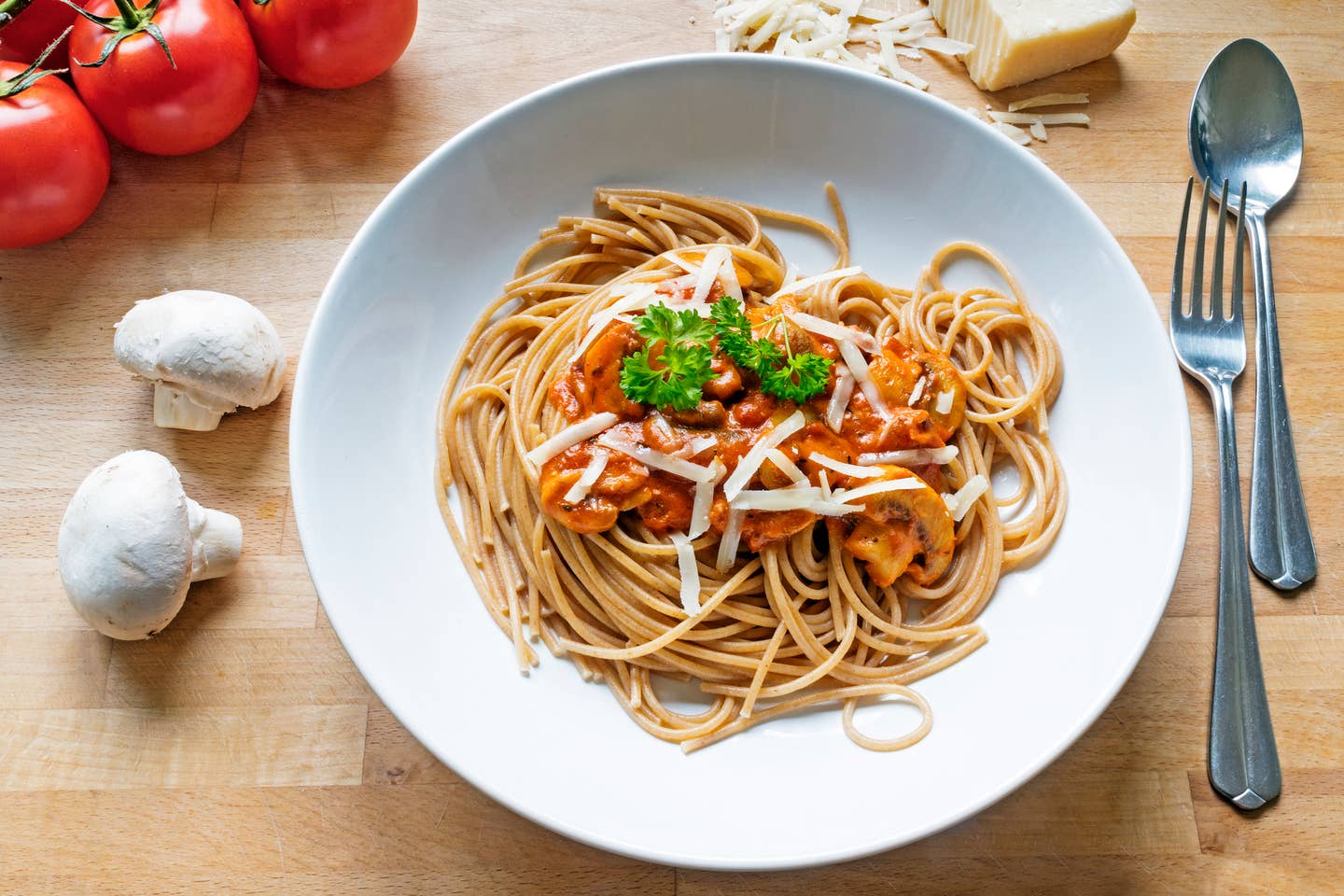
“I Tried High-Protein Sorghum Pasta and Here’s What It Tastes Like”
When you look at a bowl of your favorite pasta, do you see a pile of unhealthy carbs? Or an opportunity to eat a dish full of healthy protein-rich, fiber-filled antioxidant-packed whole grains? Now your bowl of pasta can also be a health food! If you eat sorghum pasta.
Unlike regular refined wheat pasta, or even whole wheat pasta, which are both high in carbs and can cause a spike in blood sugar, spaghetti made from sorghum is one of the healthiest and most fiber-filled pasta you can eat. But what does it taste like? I set out to find out.
First what is sorghum?
Sorghum is one of the most prevalent crops in the world, but unlike elsewhere in the world, in America it is mostly used to feed livestock and farm animals used as work animals since it's a reliable and steady form of fuel. Sorghum has not been considered human food, until now. But that is fast changing, since the nutritional profile of sorghum makes it one of the most healthy superfood options you can put on your plate, or into your body.
An ancient grain that originated in Africa, sorghum is now grown in many countries, including the US. Why such growing popularity? It is naturally gluten free and Non-GMO and is known as an environmental superstar since it grows using fewer natural resources such as water.
Adding to sorghum's growing status as an environmental "hero food," sorghum is super efficient at pulling CO2 out of the atmosphere and replacing it into the soil, something that is being studied with a Bezos Earth Fund grant at Salk Institute's Harnessing Plant Initiative, to see if a hearty form of the plant could be bred to help reverse CO2 emissions and slow down climate change.
Read More: If you are someone who shops and eats with the climate in mind, these are the Best and Worst Whole Grains for the Environment.
Sorghum is a Health Hero
Sorghum is packed with health benefits: High in protein, fiber and antioxidants. Just to start, it has 10 grams of protein in a half a cup of sorghum, along with 6 grams of fiber and a host of healthy nutrients such as: Potassium, Niacin, Thiamin, Vitamin B6, and Magnesium, and Maganese. Sorghum's benefits reads like a multivitamin of whole foods.
Whole grains like sorghum are a dieter's friend. As with other whole grains that are minimally processed, sorghum supports a healthy digestive system, by helping slow down absorption of calories, which keeps you feeling full longer than refined simple carbs that spike blood sugar, releasing insulin that messages to the cells that, unless they can use all that surging glucose, the body will store it, as fat, to be used later.
Because it is gluten-free, sorghum is now used in more than 350 products in the US market, including pasta, syrup and an alcohol that helps fill out the nutritional value of other foods.
When you look for pasta and read labels, if choosing the noodles with the most protein is a priority, you may also want to try edamame pasta, red lentil pasta, or chickpea pasta which have 43 grams, 22 grams and 21 grams of protein per serving, respectively. For a complete list of healthy high-protein pasta options, check out Healthy Pastas With the Most Protein.
How Does Sorghum Pasta Stack Up?
When I tried sorghum pasta, I expected it to taste and act like other gluten-free noodles I had tasted, which were nothing special and always lacked that perfect pasta "bite" when cooked. And while these sorghum noodles are indeed gluten-free (since they are not made from wheat flour but from sorghum flour) they actually tasted more like chewy, al dente whole wheat pasta, with a mild nutty flavor, which liked.
The Sorghum Spaghetti from Gundry MD promises to be one of the healthiest organic sorghum superfoods on the planet, but it tastes as good as your favorite pasta, only a little tougher. Dr. Steven Gundry is known as the doctor who helps solve "leaky gut syndrome" by helping people change their diets and avoid lectins. He has written several best-selling books on the topic, including The Plant Paradox, The Longevity Paradox, and The Energy Paradox.
I Made Cacio e Pepe with Sorghum Pasta and Dairy-Free Cheese
My sorghum experiment started when I added olive oil, minced fresh garlic cloves, pepper corn, pine nuts and salt into a sauce pan and heated it up as a way of creating a "pure" taste test and not smothering the sorghum noddles with red sauce. I wasn't following any specific recipe, just winging it and adding more garlic than a person should, which is always my go-to.
In a separate pot, I boiled the water and added the Sorghum Spaghetti from Dr. Gundry, whose write up promises that sorghum is not only gluten-free and better for you but will also help with digestion. Since it is lectin-free, anyone with an allergic reaction or sensitive to lectin foods will appreciate this pasta option.
After the oil mixture began to slightly burn and the pasta was al dente, I combined the noodles into the sauce and mixed them around. Because they were still sticking together, the pasta started to smoke and slightly crisp up, like a nest of potatoes, but this one of spaghetti. I added shaved dairy-free parmesan (but if you are not trying to be plant-based regular would do) and the dish began to take on a life of its own.
Once cooked through, the noodles were slightly crisp and brown on the outside, and the whole dish was more of a hardened hash brown like (but you could call it pasta-browned) meal than I had anticipated. In other words I may have burned the noodles but instead of getting soggy they became crisp, which I love.
I sat down with a glass of rose and "cut" the pasta into small fork-fulls and it was absolutely delicious. Perhaps because I didn't need the noodles to taste exactly like the ordinary while pasta variety, I actually preferred the sorghum pasta to my usual fare.
Should You Eat Sorghum Noodles?
Despite all the health benefits of sorghum, what most people don't realize (and the nutrition labels won't tell you) is that many of the beneficial ingredients in the sorghum pass right through you and are not absorbed by the body. That's because the way the protein, specifically, is encased in the shaft is virtually impossible for the body to break down.You might as well be eating it still wrapped in its cardboard box.
According to a food scientist at Purdue, Sorghum offers unique properties that make it healthier than wheat pasta, such as the fact that it's full of antioxidants, fiber, protein and trace minerals your body needs. Yet it also has such a solid fiber wall surrounding the protein that most of these nutrients pass through the body unabsorbed – only an estimated 46 percent of the sorghum protein you eat gets absorbed, the Purdue report says. (The Purdue work led to the development of a type of sorghum variety that is 87 percent digestible in laboratory tests.)
But if low or steady blood sugar is a goal, then avoiding the spikes that follow a heaping bowl of regular refined wheat pasta can make sorghum the perfect choice for your spaghetti, since the very fact that sorghum is hard for humans to digest means you can eat more of it and your body holds onto fewer calories that you're consuming.
According to one source, the glycemic index of white pasta is between 42 and 45, while whole grain barley has a GI score of 25. Whole wheat pasta has a GI score of about 37.
| Grain Food | GI Score |
| Whole grain barley | 25 |
| Rye berries | 35 |
| Buckwheat | 45 |
| Brown rice | 48 |
| Whole wheat pasta | 37 |
| “White” pasta | 45 |
The GI index of sorghum is in the medium low range but the actual number depends on the product, since sorghum itself is in the medium to low range.
In a study of the glycemic index or load of sorghum products versus those made with other flour sources, including pasta, the GI of sorghum-based foods was "significantly lower than that of their respective control (wheat/rice-based) foods. All sorghum-based foods showed significantly lower than their respective control (wheat/rice-based) foods."
Bottom Line: Sorghum Pasta Is a Healthier Substitute for Regular Wheat Pasta
When it comes to pasta, everyone gets to make the choice whether they want to indulge in their favorite regular wheat version, or try to lower their GI impact with whole wheat, or go even further and increase their fiber and protein intake with pasta made from sorghum flour. The taste and texture will be similar, if you cook it just to your liking.
More From The Beet






